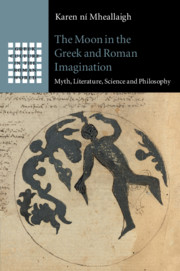48 results
Chapter 4 - The Moon of Many Faces
- from Part II - The Moon in the Scientific Imagination
-
- Book:
- The Moon in the Greek and Roman Imagination
- Published online:
- 09 October 2020
- Print publication:
- 22 October 2020, pp 146-202
-
- Chapter
- Export citation
Index
-
- Book:
- The Moon in the Greek and Roman Imagination
- Published online:
- 09 October 2020
- Print publication:
- 22 October 2020, pp 317-320
-
- Chapter
- Export citation
Dedication
-
- Book:
- The Moon in the Greek and Roman Imagination
- Published online:
- 09 October 2020
- Print publication:
- 22 October 2020, pp vii-viii
-
- Chapter
- Export citation
Chapter 2 - Making Sense of the Moon
- from Part II - The Moon in the Scientific Imagination
-
- Book:
- The Moon in the Greek and Roman Imagination
- Published online:
- 09 October 2020
- Print publication:
- 22 October 2020, pp 51-111
-
- Chapter
- Export citation
Acknowledgements
-
- Book:
- The Moon in the Greek and Roman Imagination
- Published online:
- 09 October 2020
- Print publication:
- 22 October 2020, pp x-xi
-
- Chapter
- Export citation
Chapter 5 - The Imaginary Moon
- from Part III - The Moon in the Fantastic Imagination
-
- Book:
- The Moon in the Greek and Roman Imagination
- Published online:
- 09 October 2020
- Print publication:
- 22 October 2020, pp 205-260
-
- Chapter
- Export citation
Contents
-
- Book:
- The Moon in the Greek and Roman Imagination
- Published online:
- 09 October 2020
- Print publication:
- 22 October 2020, pp ix-ix
-
- Chapter
- Export citation
Envoi
- from Part III - The Moon in the Fantastic Imagination
-
- Book:
- The Moon in the Greek and Roman Imagination
- Published online:
- 09 October 2020
- Print publication:
- 22 October 2020, pp 291-294
-
- Chapter
- Export citation
Copyright page
-
- Book:
- The Moon in the Greek and Roman Imagination
- Published online:
- 09 October 2020
- Print publication:
- 22 October 2020, pp vi-vi
-
- Chapter
- Export citation
Part I - The Moon in the Mythic Imagination
-
- Book:
- The Moon in the Greek and Roman Imagination
- Published online:
- 09 October 2020
- Print publication:
- 22 October 2020, pp 1-48
-
- Chapter
- Export citation
Chapter 1 - The Moon in Ritual, Myth and Magic
- from Part I - The Moon in the Mythic Imagination
-
- Book:
- The Moon in the Greek and Roman Imagination
- Published online:
- 09 October 2020
- Print publication:
- 22 October 2020, pp 8-48
-
- Chapter
- Export citation
Part III - The Moon in the Fantastic Imagination
-
- Book:
- The Moon in the Greek and Roman Imagination
- Published online:
- 09 October 2020
- Print publication:
- 22 October 2020, pp 203-294
-
- Chapter
- Export citation
Chapter 6 - Selēnoskopia
- from Part III - The Moon in the Fantastic Imagination
-
- Book:
- The Moon in the Greek and Roman Imagination
- Published online:
- 09 October 2020
- Print publication:
- 22 October 2020, pp 261-290
-
- Chapter
- Export citation
Introduction
- from Part I - The Moon in the Mythic Imagination
-
- Book:
- The Moon in the Greek and Roman Imagination
- Published online:
- 09 October 2020
- Print publication:
- 22 October 2020, pp 3-7
-
- Chapter
- Export citation
Chapter 3 - Life on the Moon
- from Part II - The Moon in the Scientific Imagination
-
- Book:
- The Moon in the Greek and Roman Imagination
- Published online:
- 09 October 2020
- Print publication:
- 22 October 2020, pp 112-145
-
- Chapter
- Export citation
Bibliography
-
- Book:
- The Moon in the Greek and Roman Imagination
- Published online:
- 09 October 2020
- Print publication:
- 22 October 2020, pp 295-316
-
- Chapter
- Export citation
Abbreviations, Text References and Translations
-
- Book:
- The Moon in the Greek and Roman Imagination
- Published online:
- 09 October 2020
- Print publication:
- 22 October 2020, pp xii-xiv
-
- Chapter
- Export citation
Part II - The Moon in the Scientific Imagination
-
- Book:
- The Moon in the Greek and Roman Imagination
- Published online:
- 09 October 2020
- Print publication:
- 22 October 2020, pp 49-202
-
- Chapter
- Export citation
Index Locorum
-
- Book:
- The Moon in the Greek and Roman Imagination
- Published online:
- 09 October 2020
- Print publication:
- 22 October 2020, pp 321-322
-
- Chapter
- Export citation

The Moon in the Greek and Roman Imagination
- Myth, Literature, Science and Philosophy
-
- Published online:
- 09 October 2020
- Print publication:
- 22 October 2020



